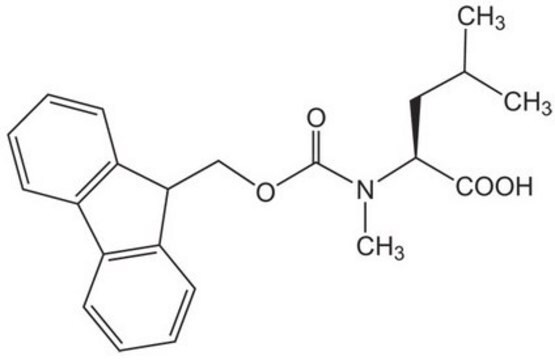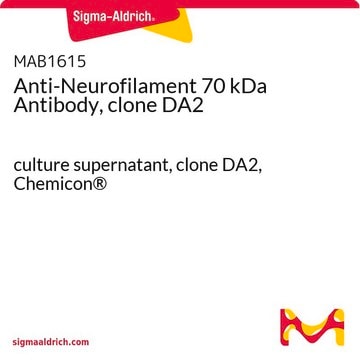おすすめの製品
由来生物
rabbit
品質水準
抗体製品の状態
serum
抗体製品タイプ
primary antibodies
クローン
polyclonal
化学種の反応性
avian, reptile
化学種の反応性(ホモロジーによる予測)
mammals
メーカー/製品名
Chemicon®
テクニック
immunohistochemistry (formalin-fixed, paraffin-embedded sections): suitable
western blot: suitable
NCBIアクセッション番号
UniProtアクセッション番号
輸送温度
dry ice
ターゲットの翻訳後修飾
unmodified
遺伝子情報
human ... NEFH(4744)
詳細
Neurofilaments are a type of intermediate filament that serve as major elements of the cytoskeleton supporting the axon cytoplasm. They are the most abundant fibrillar components of the axon, being on average 3-10 times more frequent than axonal microtubules. Neurofilaments (10nm in dia.) are built from three intertwined protofibrils which are themselves composed of two tetrameric protofilament complexs of monomeric proteins. The neurofilament triplet proteins (68/70, 160, and 200 kDa) occur in both the central and peripheral nervous system and are usually neuron specific. The 68/70 kDa NF-L protein can self-assemble into a filamentous structure, however the 160 kDa NF-M and 200 kDa NF-H proteins require the presence of the 68/70 kDa NF-L protein to co-assemble. Neuromas, ganglioneuromas, gangliogliomas, ganglioneuroblastomas and neuroblastomas stain positively for neurofilaments. Although typically restricted to neurons, neurofilaments have been detected in paragangliomas and adrenal and extra-adrenal pheochromocytomas. Carcinoids, neuroendocrine carcinomas of the skin, and oat cell carcinomas of the lung also express neurofilaments. For more neurofilament information see Nervous System Cell Type Specific Marker chart online under the CHEMICON Technical Support section.
特異性
Strong reactivity to the major neurofilament subunit HF-H. Since a second neurofilament subunit, NF-M, also contains a few lysine-serine-proline (KSP) sequences, there is generally some reactivity with this protein also. AB1991 stains both phosphorylated and dephosphorylated neurofilaments.
免疫原
E. Coli recombinant fusion protein containing 37 lysine-serine-proline repeats of rat NF-H.
Epitope: lysine-serine-proline repeat
アプリケーション
Research Category
ニューロサイエンス
ニューロサイエンス
Research Sub Category
ニューロフィラメント及び神経細胞代謝
神経細胞及びグリアマーカー
ニューロフィラメント及び神経細胞代謝
神経細胞及びグリアマーカー
Detect Neurofilament H (200 kDa) using this Anti-Neurofilament H (200 kDa) Antibody, lysine-serine-proline repeat validated for use in IH(P), WB, IH.
Immunohistochemistry: 1:250-1:1,000 AB1991 is not affected by the level of neurofilament phosphorylation and is particularly good for revealing dendritic and perikaryal neurofilaments.
Immunoblotting
Electron microscopy
Optimal working dilutions must be determined by end user.
Immunoblotting
Electron microscopy
Optimal working dilutions must be determined by end user.
物理的形状
Neat rabbit antisera.
保管および安定性
Maintain at -20°C in undiluted aliquots for up to 12 months. Avoid repeated freeze/thaw cycles.
法的情報
CHEMICON is a registered trademark of Merck KGaA, Darmstadt, Germany
免責事項
Unless otherwise stated in our catalog or other company documentation accompanying the product(s), our products are intended for research use only and are not to be used for any other purpose, which includes but is not limited to, unauthorized commercial uses, in vitro diagnostic uses, ex vivo or in vivo therapeutic uses or any type of consumption or application to humans or animals.
Not finding the right product?
Try our 製品選択ツール.
保管分類コード
10 - Combustible liquids
WGK
WGK 1
引火点(°F)
Not applicable
引火点(℃)
Not applicable
適用法令
試験研究用途を考慮した関連法令を主に挙げております。化学物質以外については、一部の情報のみ提供しています。 製品を安全かつ合法的に使用することは、使用者の義務です。最新情報により修正される場合があります。WEBの反映には時間を要することがあるため、適宜SDSをご参照ください。
Jan Code
AB1991:
試験成績書(COA)
製品のロット番号・バッチ番号を入力して、試験成績書(COA) を検索できます。ロット番号・バッチ番号は、製品ラベルに「Lot」または「Batch」に続いて記載されています。
Hongyang Jing et al.
Cell & bioscience, 11(1), 105-105 (2021-06-07)
The neuromuscular junction (NMJ) is a peripheral synapse critical to muscle contraction. Like acetylcholine receptors (AChRs), many essential proteins of NMJ are extremely concentrated at the postjunctional membrane. However, the mechanisms of synapse-specific concentration are not well understood; furthermore, it
J A Christianson et al.
Neuroscience, 145(1), 303-313 (2007-01-16)
Human diabetic patients often lose touch and vibratory sensations, but to date, most studies on diabetes-induced sensory nerve degeneration have focused on epidermal C-fibers. Here, we explored the effects of diabetes on cutaneous myelinated fibers in relation to the behavioral
G-Y Xu et al.
Neuroscience, 153(4), 1034-1047 (2008-04-22)
The toxicity of released glutamate contributes substantially to secondary cell death following spinal cord injury (SCI). In this work, the extent and time courses of glutamate-induced losses of neurons and oligodendrocytes are established. Glutamate was administered into the spinal cords
Karra A Muller et al.
Diabetes, 57(6), 1693-1701 (2008-03-26)
Large-fiber diabetic polyneuropathy (DPN) leads to balance and gait abnormalities, placing patients at risk for falls. Large sensory axons innervating muscle spindles provide feedback for balance and gait and, when damaged, can cause altered sensorimotor function. This study aimed to
Genxia He et al.
Microscopy research and technique, 80(9), 1009-1017 (2017-05-26)
It was known that Spinal cord injury (SCI) leads to neuronal cell death, axonal damage and demyelination, and often results in severe functional loss. Noninvasive imaging of axonal integrity may hold great importance in clinic. This study evaluated the role
ライフサイエンス、有機合成、材料科学、クロマトグラフィー、分析など、あらゆる分野の研究に経験のあるメンバーがおります。.
製品に関するお問い合わせはこちら(テクニカルサービス)






